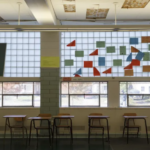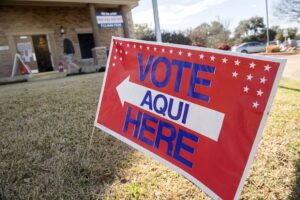District and charter schools across Michigan have $6 billion in federal pandemic relief funds to spend — but some of the planned uses are not explicitly pandemic-related, according to spending proposals submitted to the state.
Among them: A playground ball pit, metal detectors, a food truck, and a nutrition room with smoothie service.
Schools have a lot of flexibility in using the influx of federal money — and just a few years to spend it. Proposed uses vary greatly among the more than 500 school districts and nearly 300 charter schools, and cover nearly everything from athletic fields to food trucks, according to a review by the Detroit Free Press in collaboration with Chalkbeat Detroit and Bridge Michigan.
When asked about non-COVID related spending, school district leaders said they believed spending on athletics and similar categories fit under the broad umbrella of student well-being. Others said they were making infrastructure and building improvements they’ve already waited too long to make, thanks to years of inadequate state funding.
“School districts and school administrators, really, we’re doing our due diligence to be responsible with taxpayer funding,” said Susan Tollefson, superintendent of L’Anse Area Schools in the Upper Peninsula.
Schools received three rounds of federal relief funding, starting in 2020 through the CARES Act, with the last and biggest round of funding in the American Rescue Plan last year.
Congress did not attach a lot of stipulations to the money, leaving schools quite a bit of discretion in spending. In signing off on the most significant and last influx of cash in the American Rescue Plan, Biden said he hoped the funds would, in part, help schools reopen amid the pandemic. Congress also stipulated that at least 20% of the third round of funds be used to combat learning loss sustained in the pandemic. Schools are also expected to meaningfully consult with stakeholders in their communities in developing spending plans, including students, families, and educators.
The last round of money needs to be spent by 2024. Plans for spending the money submitted to the state are still preliminary and could change. The amount of money allocated to districts and schools depended on a few factors, including the number of students enrolled and the number of students from low-income households. Districts with more of those students received more funding.
Experts in school finance and administration caution that schools should strategize to spend this money carefully, and target their investments toward helping students academically and mentally. But, they added, there may also be room for new playground equipment. Guidelines attached to the money are loosely written, allowing for schools to come up with creative ways to spend it.
“We’ve got to invest our dollars in the things we know work and do that in a way where we’re making sure that those investments go to the students who need it the most,” said Karen Hawley Miles, president of Education Resource Strategies, a national nonprofit that assists schools with using resources wisely.
Security, wellness, buildings
Some of the most common non-COVID-related spending categories include security, athletics, playground equipment, and infrastructural improvement such as new HVAC systems.
But what exactly is considered pandemic-related is up for debate among schools.
In their proposals to buy security equipment, some schools wrote that they would use cameras for contact tracing. Hope Academy, a K-8 charter school in Detroit, for example, wrote in state records that interior and exterior cameras at the school “will be used to assist in the process of contact tracing (as needed) as well as to monitor the daily adherence to COVID-19 procedures and protocols at the school level.”
Hope Academy’s superintendent did not respond to an emailed request to explain the school’s contact tracing process.
Kalamazoo Public Schools is also using some of its $60 million in federal funds for pricey security equipment — three metal detectors estimated at $8,000 each and five X-ray machines at $22,000 each, according to state data. Superintendent Rita Raichoudhuri wrote in an emailed statement that the equipment is used for special events. Existing equipment is older and in need of replacement, she wrote. She did not say how the devices relate to the pandemic.
“The replacement devices will enable the district to continue its operations using newer equipment to keep our students and community safe,” she wrote.
Michigan schools also included playground, athletic, and wellness equipment in spending plans.
The River Rouge School District proposed at least $340,000 in athletics, playground and wellness spending out of the roughly $16 million the district received. About $10,000 would go to a nutrition room to make smoothies, according to River Rouge’s plan.
The room would “provide smoothies and other essential drinks to support the additional calories, carbohydrates, proteins, and a host of other essential nutrients for student athletes participating in rigorous after-school athletic conditioning and programming.”
River Rouge also proposed spending $120,000 to buy a food truck for a mobile culinary arts program for high school students and more than $200,000 on new playground equipment. The district did not respond to requests for interviews about its spending strategy, but wrote in the state documents that the playground equipment would benefit student well-being.
Spending on a playground, athletics or building repairs might even fit into a district’s strategic plan to spend the money, Hawley Miles said. Districts may have planned in the future to make those improvements, spreading out the expense over years. By spending the federal funds now, schools could be freeing up money later.
In that case, she said, “it could be responsible to spend money on a playground.”
Tollefson’s district, L’Anse Area Schools, planned to spend nearly $93,000 on installing new outdoor tennis courts. The superintendent believes the spending is COVID-related because it provides another option for student activities outdoors and addresses concerns parents have raised about students exercising indoors when face masks are required.
Tollefson added that the new courts aren’t just for tennis, and can also be used for pickleball and other racket sports, too.
“Our plan was to hold PE classes outside as much as possible,” she said.
And the decision to install them wasn’t made in a vacuum, she said. Parents and teachers had input on the district’s plan to spend the $1.7 million it received, which also included plenty of COVID-related items, like thermometers and hand sanitizer.
Building expenses
Schools are also spending hundreds of millions of dollars on building expenses that aren’t entirely pandemic-related — Detroit Public Schools Community District’s $700 million spending plan is one of the most stark examples. The district received $1.2 billion in federal funding and is relying on the majority, nearly $700 million, for its building projects.
Detroit’s school building problems are well-documented and persistent, including mold and asbestos issues. School leaders across the state say Michigan hasn’t adequately funded building needs, leading to broken HVAC units, roofing issues and more.
Just north of Detroit, Eastpointe Community Schools is also targeting some of its spending to take care of long-standing infrastructure problems. The district, with nearly $30 million in federal relief funding, proposed spending $500,000 to demolish Eastpointe High School’s aging swimming pool, now in disrepair. Robert Carlesso, director of finance with Eastpointe, said it would take $300,000 at least to make the pool operational.
The number of students attending Eastpointe High has declined dramatically since the high school was first built 100 years ago, he said. In the long run, it’s cheaper to demolish the pool and make the school smaller.
“If we were able to reduce the footprint of that building, we would have more money to put into classrooms long term,” he said.
Building improvements might not necessarily be COVID-related, Carlesso said, but the improvements will hopefully make the district “a place that people want to go to school.”
Similar to L’Anse, Alcona Community Schools, a small rural district in northeastern Michigan had an “existing list of needs” for both students and facilities. Superintendent Daniel O’Connor said the decision to replace 30-year-old playground equipment, at an estimated expense of roughly $200,000, balanced student needs in the pandemic, keeping them outside where it’s harder to transmit infection.
“We have $10 million, $20 million worth of needs that aren’t all as dire as some of the others,” he said. “We tried to really look at student data to guide our decision-making process and trying to be responsive to their needs.”
Strategic spending
To Kobe Rochester, a senior at Sexton High School in Lansing, his school’s needs feel apparent. In a Facebook post in March, the 17-year-old wrote that his school’s bathrooms were a mess, missing soap for months on end and in desperate need for updates. He also believes his school needs more security.
“You’d think in the middle of COVID that soap in the bathroom would be a priority,” he wrote.
Principal Dan Boggan said in an email response to the Free Press that the bathrooms lack soap dispensers because the school was hit by a social media challenge that encouraged students to damage school bathrooms. The school placed hand sanitizer stations outside of bathrooms in lieu of soap.
Robert Kolt, a spokesperson with Lansing Public Schools, wrote that an upcoming bond vote in May includes $10 million to make improvements to Sexton High facilities, which Rochester said generally needs updates.
Rochester told the Free Press that the bathrooms sometimes don’t have toilet paper. He said it doesn’t appear like the district has poured any federal money into needs the students like him have identified, like security.
Leading experts, however, have cautioned school leaders to focus not just on infrastructure or miscellaneous needs, but also on academic and emotional well-being to help students truly recover from the devastating impacts of the pandemic. Early benchmark testing through last year showed more Michigan students fell behind their grade level in math and reading, with students from low-income families and students of color faring worse.
The Council of the Great City Schools, a coalition of more than 70 public school districts across the United States, recommends having “a coherent, instructionally focused, systemwide plan.”
The organization studied how districts used federal funding from 2009 following the Great Recession. The districts that used the funding more effectively and saw better results had coherent strategies for improving academics districtwide.
Hawley Miles said districts should be leveraging research-based practices, like high-dosage tutoring where students receive tutoring one-on-one or in small groups several times a week, as a part of those plans — and they should be capturing data, like results of routine student testing, to gauge the success of those interventions.
In some cases, she said, districts across the country are struggling to spend some of the funding on tutoring and hiring other employees for instruction because of the current competitive job market.
“We’re working in a place where they expected to spend $50 million on tutoring, and it was a big district, but they could only spend five,” she said.
But generally, catching up struggling students should drive district decisions, she said.
“Do they have the plans for how they’re going to assess what students know and where they need help to catch up? Do they have extra time for tutoring students?” she asked.
This article was originally posted on Michigan schools take advantage of broad discretion in COVID spending











More Stories
More West Virginia schools will participate in opioid abuse prevention program
Pennsylvania is increasingly underfunding special education, report finds
Memphis’ Kingsbury High School community steps up call for changes